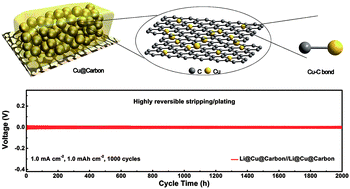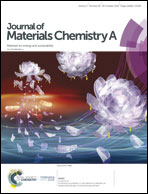Nano-Cu-embedded carbon for dendrite-free lithium metal anodes†
Abstract
Lithium metal has been considered as a promising anode material for a long time because of its inherent high capacity and low potential. However, dendrite formation upon cycling hinders its application. Herein, a nano-Cu-embedded porous carbon (Cu@carbon) is synthesized by a simple heat treatment of a Cu–organic framework, and is then applied as a host for Li plating/stripping. It is found that the nano-Cu particles are uniformly embedded in the bulk and surface of the carbon, integrating high conductivity and high surface area. DFT calculations and experimental data indicate that the CuCx formed at the interface can serve as lithiophilic sites for Li nucleation and growth. As a result, the host material exhibits a dendrite-free Li plating/stripping. The half cell (Li‖Cu@carbon) shows a high coulombic efficiency of 99.3% over 200 cycles even with a high cycling capacity of 4 mA h cm−2, and the Li@Cu@carbon based symmetric cell can be cycled stably for over 2000 h at 1.0 mA cm−2. Furthermore, the corresponding Li-metal capacitor (activated carbon‖Li@Cu@carbon) and battery (LiFePO4‖Li@Cu@carbon) exhibit high cycling stability, with 80.1% capacity retention after 10 000 cycles (capacitor) and 94.7% capacity retention after 1000 cycles (battery). These achievements make our anode among the most stable Li anodes reported so far.

- This article is part of the themed collection: 2019 Journal of Materials Chemistry A HOT Papers


 Please wait while we load your content...
Please wait while we load your content...